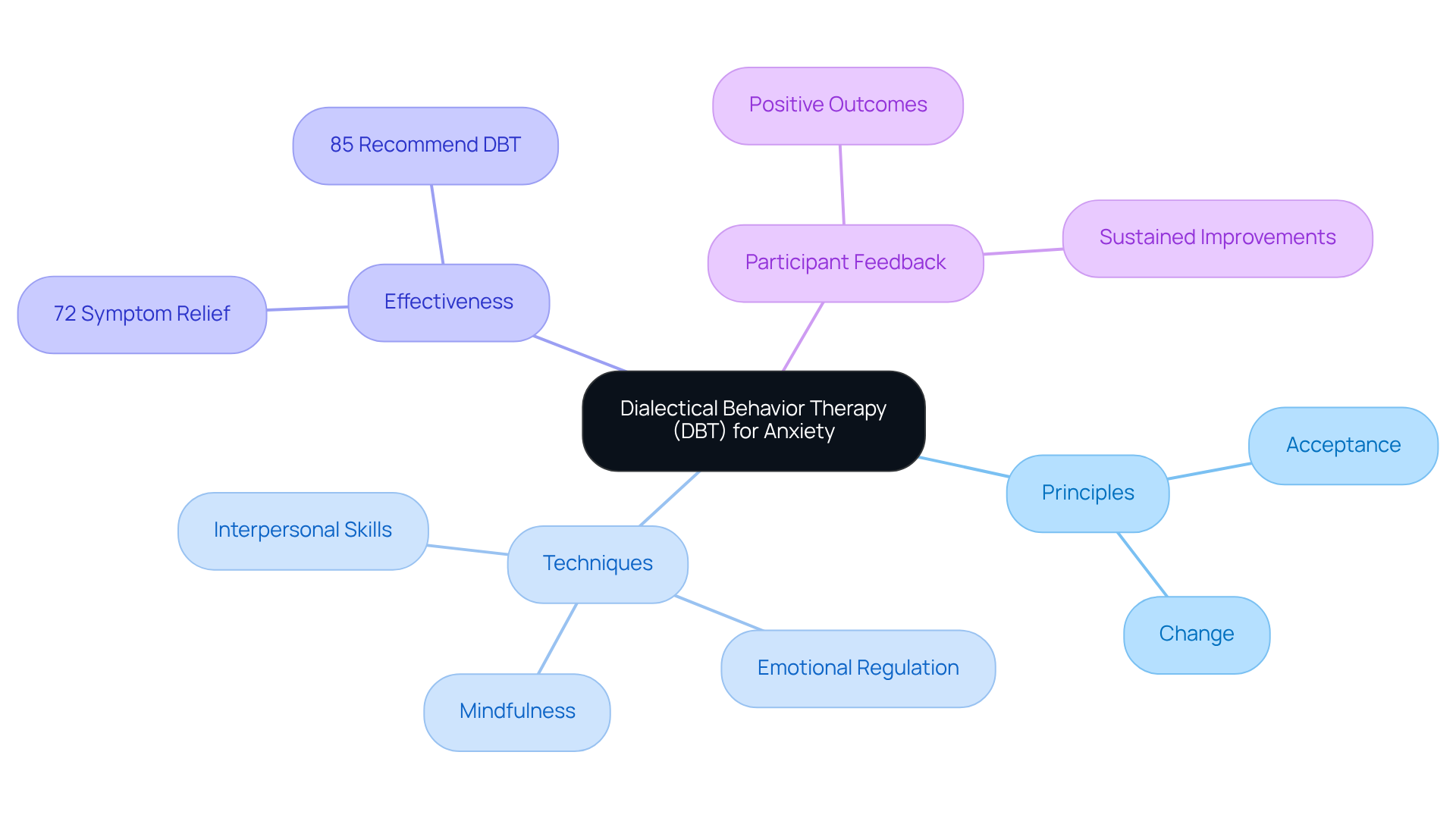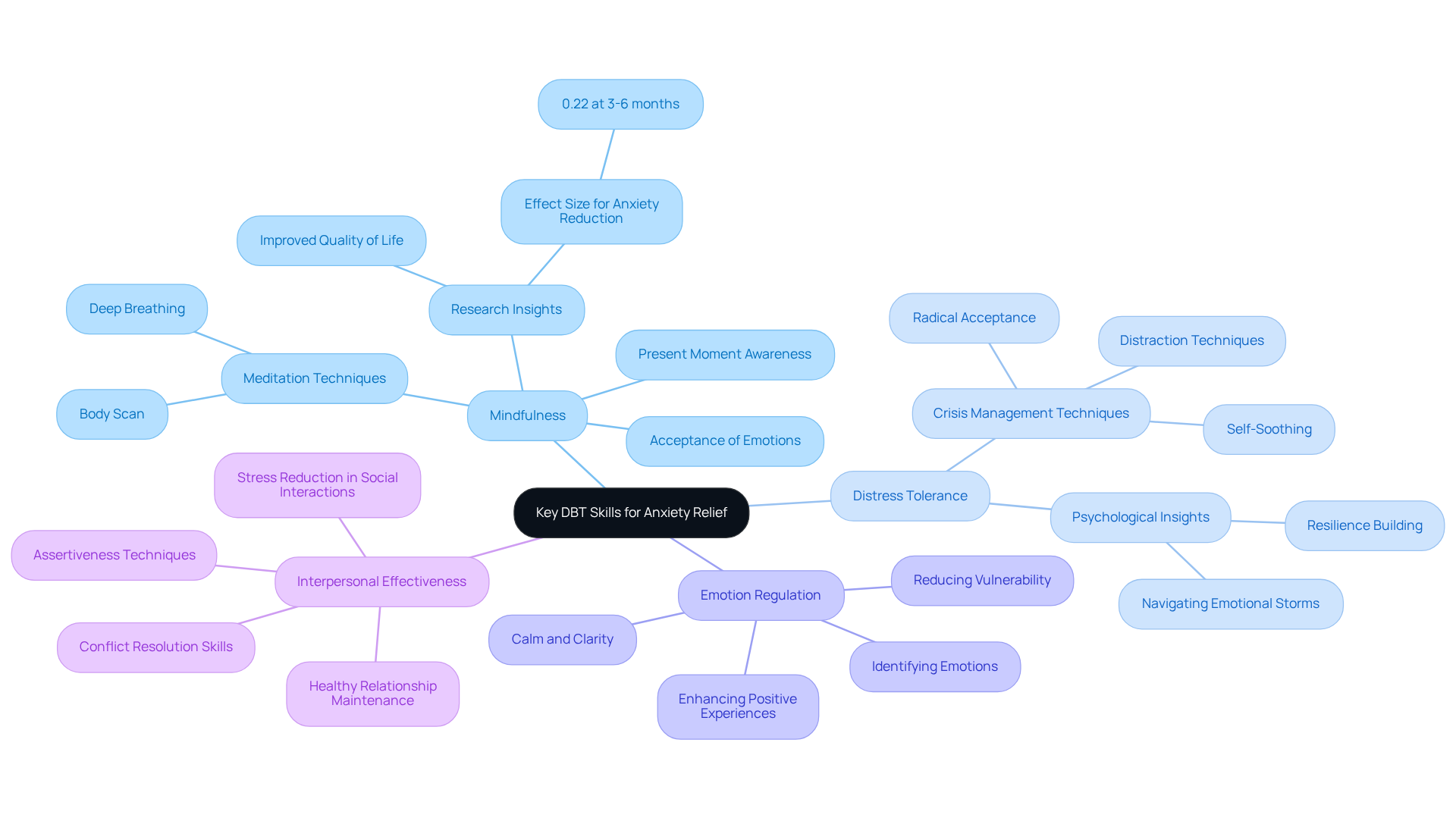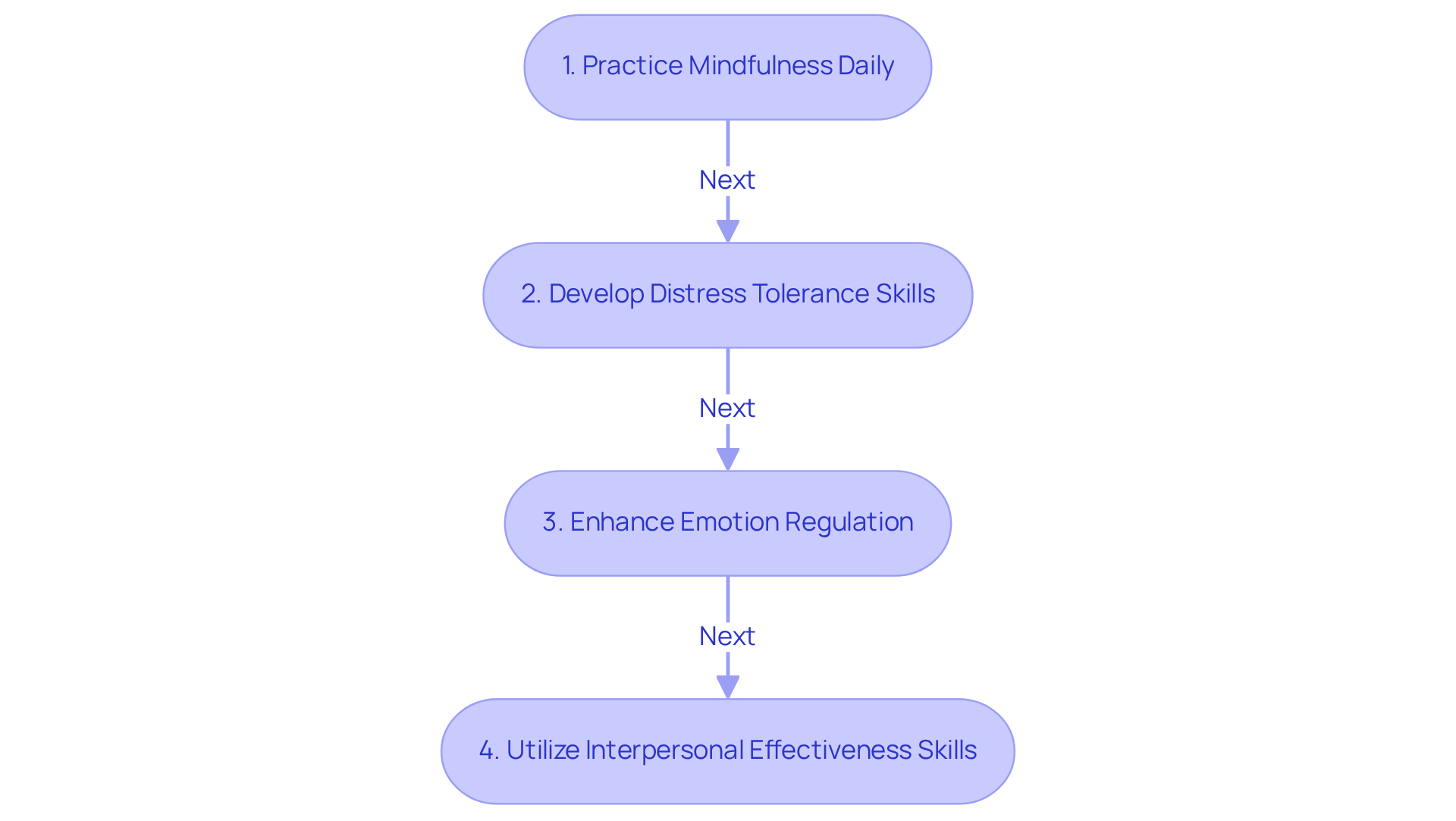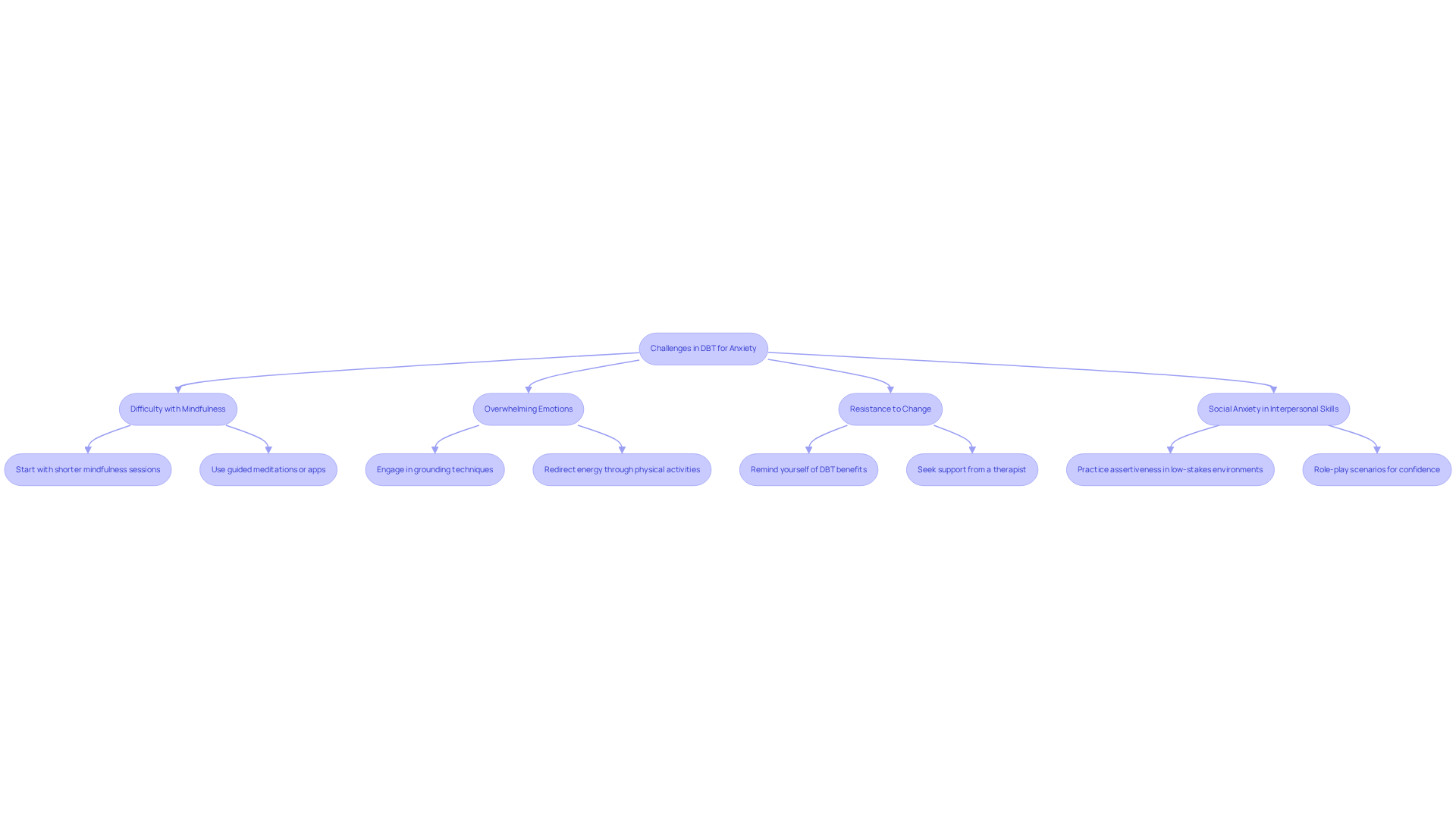Overview
Dialectical Behavior Therapy (DBT) is a compassionate approach for managing anxiety, blending mindfulness with cognitive-behavioral techniques to help individuals understand and cope with their emotions.
Have you ever felt overwhelmed by your feelings? This therapy offers a supportive pathway to navigate those emotions.
The article highlights key DBT skills—mindfulness, distress tolerance, emotion regulation, and interpersonal effectiveness—that empower clients to manage anxiety symptoms and enhance their overall emotional well-being.
Through structured practice and support, individuals can find relief and healing.
As we explore this further, consider how these skills might resonate with your own experiences and the possibility of seeking help for a brighter emotional future.
Introduction
Dialectical Behavior Therapy (DBT) has emerged as a powerful ally for those grappling with anxiety. By blending cognitive-behavioral strategies with mindfulness, it fosters emotional resilience. This structured approach not only aids individuals in understanding their emotions but also equips them with practical skills for managing distress.
Have you ever felt overwhelmed by your feelings? As many seek relief from their anxiety, a pressing question remains: how can one effectively implement DBT techniques in daily life to combat these overwhelming emotions and achieve lasting relief?
The journey towards emotional well-being is not just about understanding; it's about actively engaging with these strategies to find the peace you deserve.
Understand DBT and Its Role in Managing Anxiety
Dialectical Behavior Therapy (DBT) offers a structured and compassionate approach that beautifully integrates cognitive-behavioral techniques with mindfulness practices. Initially developed to assist those with borderline personality disorder, DBT for anxiety has shown effectiveness in addressing a variety of mental health challenges, particularly those related to anxiety. At the heart of DBT lies the essential principle of balancing acceptance and change, a vital element for individuals grappling with distress. This method encourages clients to cultivate awareness of their feelings and thoughts, empowering them to identify stress triggers and develop healthier coping strategies.
Research shows that DBT can significantly alleviate symptoms of worry. For example, a study revealed that 72% of individuals with major depression experienced symptom relief after participating in DBT, with these positive changes sustained at a six-month follow-up. Moreover, DBT for anxiety has proven effective in reducing harmful behaviors and emotional dysregulation, making it an invaluable resource for those facing anxiety-related distress.
Key techniques within DBT for managing stress include mindfulness exercises that enhance emotional regulation and distress tolerance. These skills enable clients to navigate their stress more effectively, fostering resilience and promoting personal growth. Additionally, group sessions provide a supportive environment for developing interpersonal skills, which can further alleviate stress symptoms.
The prevalence of anxiety-related conditions is a pressing concern, with many individuals enduring debilitating symptoms that impact their daily lives. DBT's structured framework presents a hopeful pathway for treatment, as shown by the encouraging outcomes reported by participants in various DBT programs. In a large-scale survey, 85% of participants expressed that they found DBT beneficial and would recommend it to others facing similar challenges.
In summary, DBT for anxiety employs a holistic approach that emphasizes both acceptance and change, equipping individuals with the necessary tools to manage their anxiety effectively. By nurturing a deeper understanding of their emotional landscape, clients can embark on a journey toward healing and enhanced mental well-being. Have you ever felt overwhelmed by your past? If so, consider exploring the transformative potential of DBT and how it might support you on your path to recovery.

Explore Key DBT Skills for Anxiety Relief
DBT encompasses four essential skill sets crucial for managing anxiety:
-
Mindfulness: This skill emphasizes being present in the moment and observing thoughts and feelings without judgment. Mindfulness practices, such as meditation and deep breathing, significantly lessen stress by promoting awareness and acceptance of one’s emotional condition. Research indicates that mindfulness can lead to small to moderate reductions in anxiety symptoms, with an effect size of 0.22 for anxiety at 3-6 months, enhancing overall well-being. Have you ever felt the weight of your thoughts pulling you down? Mindfulness offers a gentle way to lift that burden.
-
Distress Tolerance: This set of abilities prepares people to withstand and manage crises without turning to harmful behaviors. Techniques such as self-soothing, distraction, and radical acceptance are vital for managing overwhelming emotions. Psychologists emphasize that cultivating distress tolerance abilities is essential in DBT, as it enables individuals to manage distressing situations more effectively. As Dr. Sona Dimidjian states, "Over time, and with practice, you can develop the ability to stand back from these painful thought patterns." Imagine being able to navigate life’s storms with resilience and grace.
-
Emotion Regulation: This ability emphasizes understanding and managing intense emotions. It involves identifying emotions, reducing vulnerability to negative feelings, and enhancing positive emotional experiences. Effective emotion regulation can lessen distress and promote a more balanced emotional state. Have you noticed how emotions can sometimes feel overwhelming? Learning to regulate them can bring a sense of calm and clarity.
-
Interpersonal Effectiveness: This set of abilities instructs people on how to express their needs successfully while sustaining healthy relationships. It encompasses approaches for assertiveness and conflict resolution, which can reduce stress associated with social interactions. By mastering these abilities, individuals can navigate social situations with increased confidence and lessen stress arising from interpersonal challenges. Think about the relief of being able to communicate your needs clearly and effectively.
Integrating DBT for anxiety techniques into everyday life can greatly improve one’s capacity to handle stress, promoting a sense of control and emotional balance. The Emerald Couch emphasizes a holistic approach to mental health, providing personalized support and a safe environment for clients to explore these skills effectively. Are you ready to take the first step towards a more balanced and fulfilling life?

Implement DBT Techniques: A Step-by-Step Guide
To effectively implement DBT techniques for anxiety relief, consider these nurturing steps:
-
Practice Mindfulness Daily: Begin your journey with brief mindfulness exercises, such as deep breathing or body scans. As you grow more comfortable, gradually extend the duration. Aim for at least 10 minutes each day, as research shows that consistent mindfulness practice can significantly lower stress levels. Have you ever noticed how mindfulness can help you respond more calmly to life's challenges? Studies indicate that individuals who underwent Mindfulness-Based Cognitive Therapy (MBCT) were less likely to react with negative thoughts under stress, highlighting the profound benefits of mindfulness in managing distress.
-
Develop Distress Tolerance Skills: When feelings of overwhelm arise, embrace self-soothing techniques like taking a warm bath, listening to calming music, or engaging in a favorite hobby. Regular practice of these skills nurtures resilience and prepares you to handle stress more effectively. Participants in the Grouport DBT series have shared their experiences of improved stress management and enhanced relationships through the supportive environment of group therapy, particularly highlighting the benefits of DBT for anxiety. How might these skills help you in moments of distress?
-
Enhance Emotion Regulation: Consider maintaining a journal to track your emotions and identify triggers. Utilize emotion regulation strategies, such as naming your feelings and challenging negative thoughts, to navigate intense emotions. This reflective practice can empower you to respond to stressors with greater clarity and control. As Joy Harden Bradford beautifully states, "We can improve our relationships with others by leaps and bounds if we become encouragers instead of critics." How might this perspective shift your interactions with others?
-
Utilize Interpersonal Effectiveness Skills: Practice assertive communication by using 'I' statements to express your needs clearly. Engaging in role-playing scenarios with a trusted friend or therapist can bolster your confidence in interpersonal skills, enhancing your ability to manage relationships and alleviate stress. Elizabeth Hoge emphasizes the importance of guidance in mindfulness practices, stating, "If you want to take it seriously, you've got to get a teacher." What steps can you take to seek support in your mindfulness journey?
As you explore these techniques, remember that seeking help is a courageous step towards healing and growth.

Troubleshoot Common Challenges in Using DBT for Anxiety
Implementing dbt for anxiety can present various challenges, especially for those managing this condition. Understanding these difficulties and exploring strategies to overcome them can foster resilience and emotional well-being.
Difficulty with Mindfulness: Have you ever struggled to stay present during mindfulness exercises? Many people find this challenging. To ease into the practice, consider starting with shorter sessions and gradually extending the duration. Guided meditations or mindfulness apps can provide valuable support, helping you cultivate a more consistent practice. As Natalie Buchwald notes, "Mental health issues have become a critical concern for college students," which highlights the importance of effective mindfulness strategies.
Overwhelming Emotions: When distress tolerance methods seem inadequate during intense emotional episodes, grounding techniques can be particularly effective. Focus on your immediate surroundings or engage in physical activities to redirect your energy and regain a sense of control. Studies show that grounding methods greatly alleviate emotional suffering, with 72% of people experiencing major depression noting symptom reduction after DBT. This makes grounding techniques a vital tool in your DBT toolkit.
Resistance to Change: Embracing change can feel uncomfortable, and it’s common to hesitate about adopting new skills. Remind yourself of the long-term benefits of DBT, such as improved emotional regulation and interpersonal effectiveness. Seeking support from a therapist or joining a support group can provide motivation and encouragement during this transition. As noted in the Healthy Minds Study, approximately 76% of college students report moderate to severe psychological distress, underscoring the need for effective coping strategies.
Social Anxiety in Interpersonal Skills: If assertiveness feels daunting, have you considered practicing in low-stakes environments, such as with friends or family? Role-playing scenarios can help build your confidence and prepare you for more challenging interactions. Mental health professionals emphasize that gradual exposure to these situations can significantly enhance your comfort level and effectiveness in social settings. Many individuals find that practicing assertiveness in familiar settings helps ease anxiety in more stressful situations.
By addressing these challenges with targeted strategies, you can enhance your practice of dbt for anxiety and work towards greater emotional resilience and well-being. Remember, seeking help is a courageous step towards healing.

Conclusion
Dialectical Behavior Therapy (DBT) can be a compassionate ally in your journey to manage anxiety. By merging cognitive-behavioral strategies with mindfulness, DBT offers a holistic approach to emotional regulation. This method emphasizes the dual principles of acceptance and change, empowering you to confront your anxiety with greater awareness and healthier coping mechanisms. As you integrate DBT techniques into your daily life, you can cultivate resilience and embark on a transformative path toward improved mental well-being.
In this article, we highlight essential DBT skills—mindfulness, distress tolerance, emotion regulation, and interpersonal effectiveness—each playing a vital role in alleviating anxiety. Through practical steps, you can learn to practice mindfulness daily, develop resilience against overwhelming emotions, enhance your ability to manage intense feelings, and communicate your needs effectively. These techniques not only empower you to navigate your anxiety but also foster personal growth and healthier relationships.
Ultimately, embracing DBT for anxiety is about taking proactive steps toward healing and self-discovery. While this journey may present challenges, the rewards of emotional resilience and improved mental health are profound. By exploring and implementing these DBT techniques, you can reclaim your life from anxiety, gaining a deeper understanding of yourself and your emotional landscape. The time to act is now—consider the transformative potential of DBT and its ability to support a balanced and fulfilling life. Have you thought about how these skills could change your experience? Embrace this opportunity for growth and healing.
Frequently Asked Questions
What is Dialectical Behavior Therapy (DBT)?
Dialectical Behavior Therapy (DBT) is a structured and compassionate approach that combines cognitive-behavioral techniques with mindfulness practices, initially developed to assist those with borderline personality disorder but effective for various mental health challenges, particularly anxiety.
How does DBT help manage anxiety?
DBT helps manage anxiety by balancing acceptance and change, encouraging clients to become aware of their feelings and thoughts, identify stress triggers, and develop healthier coping strategies.
What evidence supports the effectiveness of DBT for anxiety?
Research shows that DBT can significantly alleviate symptoms of worry, with a study indicating that 72% of individuals with major depression experienced symptom relief after participating in DBT, which was sustained at a six-month follow-up.
What techniques are used in DBT to manage stress?
Key techniques in DBT for managing stress include mindfulness exercises that enhance emotional regulation and distress tolerance, helping clients navigate stress more effectively and promote personal growth.
How do group sessions contribute to DBT for anxiety?
Group sessions in DBT provide a supportive environment for developing interpersonal skills, which can further alleviate stress symptoms and enhance the overall effectiveness of the therapy.
What is the prevalence of anxiety-related conditions?
Anxiety-related conditions are a pressing concern, with many individuals experiencing debilitating symptoms that significantly impact their daily lives.
What do participants think about DBT?
In a large-scale survey, 85% of participants reported that they found DBT beneficial and would recommend it to others facing similar challenges.
What is the overall approach of DBT for anxiety?
DBT for anxiety employs a holistic approach that emphasizes both acceptance and change, equipping individuals with tools to manage their anxiety effectively and fostering a deeper understanding of their emotional landscape.




